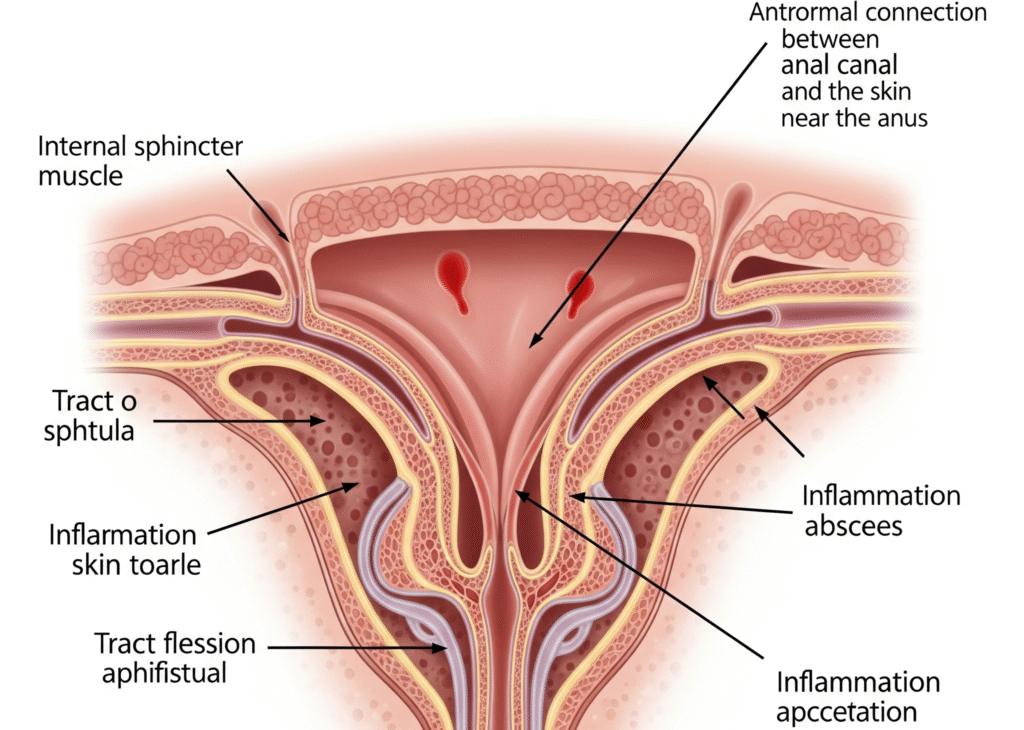Anal fistula is a chronic medical condition that has been treated for centuries using various methods from modern medicine, Ayurveda, and homeopathy. With advancements in surgical techniques, VAAFT (Video-Assisted Anal Fistula Treatment) has emerged as a minimally invasive and highly effective solution for this condition.
What Is an Anal Fistula?
An anal fistula is an abnormal tunnel-like connection between the anal canal and the skin around the anus. It generally develops due to infections in the anal glands, leading to abscesses that eventually form fistulous tracts.
Depending on its location, a fistula is classified as:
-
Low Fistula: Internal opening in the anal canal
-
High Fistula: Internal opening located deeper, possibly in the rectum or above the pelvic muscles
Causes of Anal Fistula
An anal fistula may result from:
-
Anal abscesses or gland infections
-
Chronic inflammatory bowel diseases like Crohn’s disease and ulcerative colitis
-
Diverticulitis, which causes inflammation in small intestinal pouches
-
Sexually transmitted infections like gonorrhea
-
Tuberculosis or bowel-related cancers in rare cases
Symptoms to Watch For
-
Persistent anal pain and swelling
-
Pus or fluid discharge near the anus
-
Skin irritation, redness, or itching
-
Leakage of stool or gas
-
Recurrent perianal abscesses
Diagnosis of Anal Fistula
Diagnosis begins with a detailed medical history and physical examination of the anal area. Additional tests include:
-
MRI (Magnetic Resonance Imaging) – for accurate mapping of fistula tracts
-
Endoanal Ultrasound – a detailed scan using sound waves to trace the fistula and determine its internal and external openings
These diagnostic tools help your surgeon determine whether the fistula is low or high and what treatment path is best suited.
Treatment Options for Anal Fistula
While antibiotics can temporarily ease symptoms, surgical intervention is often necessary for complete healing.
1. Conventional Fistulectomy
In this traditional surgery, the entire fistulous tract is surgically removed. The wound is generally left open and heals gradually. In complex cases, multiple procedures may be needed. A seton (surgical thread) may be placed to manage fistulas that pass through key muscles like the sphincter, reducing the risk of incontinence.
2. VAAFT – Video-Assisted Anal Fistula Treatment
A modern, minimally invasive procedure, VAAFT uses a small camera (fistuloscope) to visualize and treat the fistula from inside. The tract is cleaned and sealed, and internal openings are closed—all without large external cuts. This approach offers faster healing, less discomfort, and minimal risk of complications.
Risks & Recovery
-
Incontinence risk (especially for high fistulas)
-
Multiple sessions may be needed for deep or branching tracts
-
Healing time depends on fistula complexity and surgical method
-
Surgeons aim to preserve sphincter muscles to avoid long-term complications
Why Choose Dr. Sandhya Bade?
Dr. Sandhya Bade is a trusted Lady General Surgeon in Pune, known for her expertise in treating a wide range of anorectal conditions. With over 12 years of experience, she offers both traditional and modern solutions for anal fistula, ensuring patient safety and comfort. As a Female Specialist in Pune, she provides compassionate care in a comfortable, discreet environment for both men and women.
For patients also dealing with anal fissures, Dr. Bade offers expert Fistula Treatment in Pune, along with care for related conditions like piles and constipation.
Address:- Vignaharta, Sai Canary New Road, near Rugved Uptown, Balewadi, Pune, Maharashtra 411045
Phone:- 7769 88 1155
Get Direction



